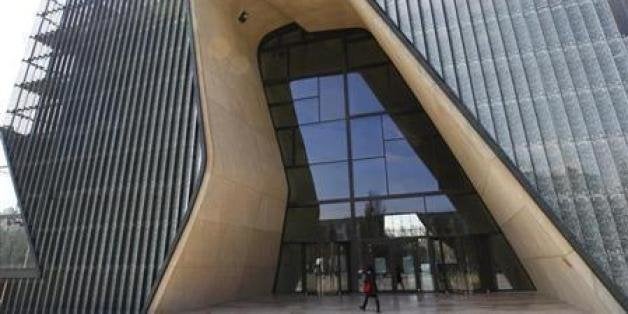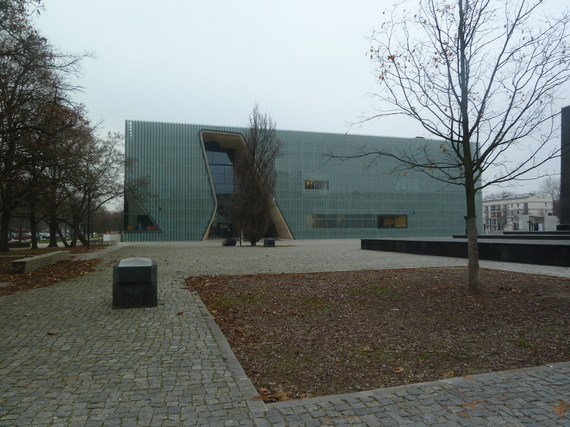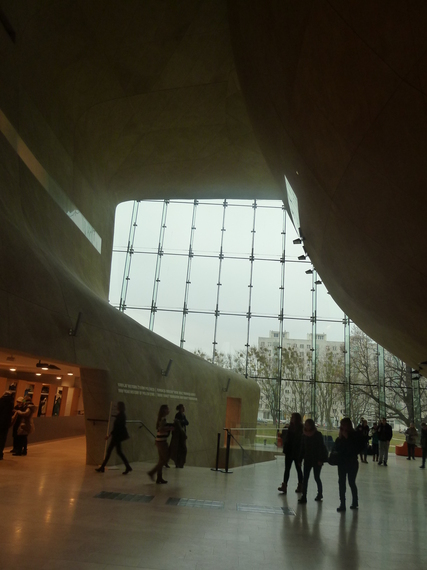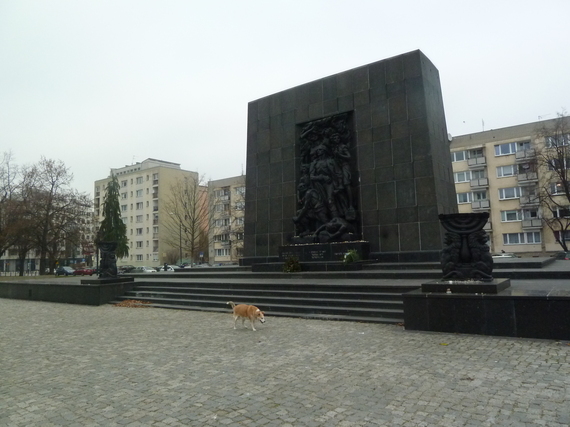
The landscape surrounding the museum is overwhelming on a day like this. The temperature is three or four degrees below zero, the sky is so gray it looks like it might split open above us, and the trees that surround the building look bare and miserable. Only a few students returning home and an elderly woman walking her dog dare to cross the plaza. Yet the museum is filled, primarily with young people, and with tourists, families, some older people and a few professorial-looking foreigners.
It has only been a few days since the central exhibition of Polin, the Museum of the History of Polish Jews, opened to the public, although the museum has existed in its current state for some time. The museum is located in the place where, between 1940 and 1943, the Nazis imprisoned roughly half a million people in a place of death and destruction. The Warsaw Ghetto is, with good reason, a place of reflection and remembrance for all of Europe, but despite the commemorative tablets -- despite the monuments to those killed during the Warsaw Uprising, and the memorial names of the streets -- its full scope has been obscured until now. In the 1950s, Polish Communist authorities decided to erect homes on top of the ruins left behind by Nazis in 1943, during the suppression of the uprising. The square kilometers once soaked in blood were swallowed up by blocks of poor, institutional buildings, giving Warsaw one of the saddest, blandest neighborhoods in the entire city. One can hardly walk through these streets, at least during the winter. It is possible, though, that the feeling of unease comes from the spirit of destruction, the negative genius lociin the soil upon which new homes were built. The workers came to live on the ashes of those that refused to be taken to Treblinka and preferred to die with dignity in an unequal and desperate fight.
The new museum, directed by an old acquaintance of mine, Dariusz Stola -- one of the foremost historians on post-war Poland -- was funded primarily through donations. An initiative started by researchers for the Institute for the History of Polish Jews grew over the years into a social movement that managed to raise funds and support from a broad range of sources. The result is something that all Europeans, at the very least, should experience.
The Warsaw museum has arrived to fill a hole, a void, that the Holocaust Museum in Washington was unable to address. Whereas the North American museum deals with the death factories, the immense crimes perpetrated by the Nazis, and an end to the story of European Judaism, the Warsaw museum, by contrast, is focused most of all on life -- on the reality of a people and a religion in the middle of Europe, living peacefully at times, and facing persecution during others, among the different peoples, religions and languages that have populated this land over time.
It is easy to overlook the depth of the relationship between the Jews and Central Europe. Along the eastern borders of the ancient Polish Republic, on the slivers of land between the Oder and Dnieper rivers, Jewish towns and villages developed around an active, communal life, engaging in commerce, art, medicine and businesses both large and small. There were Jews of every type: Orthodox, atheist and socialist; converts and members of disparate religious sects; some dressed according to European custom, and others wearing black caftans; many speaking Polish or Yiddish, praying in Hebrew or reciting Marx. Jewish life also extended to cities, like Krakow, Vilnius, and Warsaw, in which up to 25 percent of the inhabitants were considered Jewish, in one form or another. The streets of these cities were bursting with Jewish life, in cafes, cinemas and theaters featuring Yiddish, Polish, or German; in synagogues and prayer rooms; in schools and yeshivas; in small artisanal workshops, businesses, political parties, and in newspapers published in the Hebrew and Latin alphabets. There were musicians and dressmakers, poets and writers, beggars and businessmen. Ultimately, an entire civilization of European Jewry was destroyed completely and irrevocably by the Holocaust.
The museum is one of those modern, interactive museums in which visitors can participate and interact. One can stroll through a village in Austrian Galicia, tour a Warsaw street, sit in a theater, read an interwar newspaper, enter a wooden synagogue, and observe the inhabitants of a bygone world. The museum doesn't sidestep coverage of Anti-Semitic violence, or omit the persecution and the pogroms, or the destruction committed by the Nazis and their supporters. It deals with the ghettos, naturally, and Auschwitz and Treblinka. In my opinion, one of the greatest strengths of the museum is its coverage of the postwar period, when survivors of the camps returned to find that their homes were already occupied, and to once again find themselves persecuted, this time at the hands of those who had once been victims themselves. Also depicted is the communist government's cynical use of Anti-Semitism in 1968 as a tool to quell opposition demands for democratic reforms and to push out many of the last Jews in Poland on an unexpected and absurd final exodus.
But that isn't what dominates the museum. In Polin, as the Jews referred to Poland, what pervades above all is the memory of life - of a life impossible to recreate, but whose memory isn't, and shouldn't be, vain nostalgia for a lost past. On the contrary, visiting this place of reflection should remind us that the norm in the world has always been diversity - the mix of languages and cultures, the capacity to live sometimes in conflict, but always in contact with other people. In Europe, the abnormal - the aberration - has always been monolingualism, homogeneity, and the desire to assimilate all divergence and dissidence into a single majority culture.
It didn't work for the Nazis; they didn't extinguish the Jews. In the neighborhood of the former ghetto, where I now find myself in front of the museum, shivering and watching the old lady's dog run around, the gray will pass in a few months -- I know, I have seen it -- to a Polish spring of intense green. And in the same way, not very far from here, there is a Jewish school in which Jewish and Christian children coexist. Memory and hope are not the only things that remain. Amid everything else, there is also reality.
This piece was originally published on HuffPost Spain and was translated into English.


